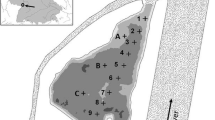Abstract
Toxicity tests with oyster larvae are becoming increasingly important as sensitive bioassays for assessing water and sediment quality. In 1983 a procedure was presented specifically for the testing of seawater elutriates of sediment samples. Testing sediment elutriates with oyster larvae in a sediment-water system invokes specific problems related to natural sediment characteristics. Experiments were set up to study the effects of these sediment properties on the bioassay results. The effects of sediment grain size, suspended solids, elutriation period, as well as the possible effects of naturally occurring toxic nutrients, like ammonia, were studied. Also the effect of presence or absence of the elutriated sediment and the distribution of larvae in the test vessels were studied.
It is concluded that natural sediment properties can have substantial effects on the test results in elutriate tests with sediment present in the test vessel. Recommendations are formulated to minimize these effects or to use other test fractions for predicting bulk sediment toxicity.
Similar content being viewed by others
References
Akkerman, I., 1991. National Evaluation Report of the Joint Monitoring Programme of the Netherlands 1990. Rijkswaterstaat, Tidal Waters Division, North Sea Directorate, The Hague/Rijswijk.
Ankley, G. T., A. Katko & J. W. Arthur, 1990. Identification of ammonia as an important sediment-associated toxicant in the lower Fox River and Green Bay, Wisconsin. Environ. Toxicol. Chem. 9: 313–322.
Ankley, G. T., M. K. Schubauer-Berigan & J. R. Dierkes, 1991. Predicting the toxicity of bulk sediments to aquatic organisms with aqueous test fractions: pore water vs. elutriate. Environ. Toxicol. Chem. 10: 1359–1366.
APHA (American Public Health Association), 1985. Standard Methods for the Examination of Water and Waste Water. 16th edn., p. 1268.
ASTM (American Society for Testing and Materials), 1991a. Standard guide for conducting static acute toxicity tests starting with embryos of four species of saltwater bivalve molluscs. ASTM Designation: E 724–89. In: Annual Book of ASTM Standards. Water and Environmental Technology. Volume 11.04. pp. 256–272. Amer. Soc. Test. Materials. Philadelphia, PA.
ASTM, 1991b. Standard guide for collection, storage, characterisation, and manipulation of sediments for toxicological testing. ASTM Designation: E 1391–90. In: Annual Book of ASTM Standards. Water and Environmental Technology. Volume 11.04. pp. 1105–1119. Amer. Soc. Test. Materials. Philadelphia, PA.
Bagarinao, T., 1992. Sulfide as an environmental factor and toxicant: tolerance and adaptations in aquatic organisms. Aquat. Toxicol. 24: 21–62.
Caldwell, R. S., 1975. Hydrogen sulfide effects on selected larval and adult marine invertebrates. Water Resources Res. Inst., WRRI-31. Oregon State Univ., Corvallis, OR.
Cardwell, R. D., S. Olsen, M. I. Carr & E. W. Sanborn, 1979. Causes of oyster larvae mortality in South Puget Sound. Tech. Mem. ERL MESA-39. Nat. Oceanic Atmos. Admin., Boulder, CO.
Carr, R. S. & D. C. Chapman, 1992. Comparison of solid-phase and pore-water approaches for assessing the quality of marine and estuarine sediments. Chem. Ecol. 7: 19–30.
Chapman, P. M. & S. Becker, 1986. Recommended protocols for conducting laboratory bioassays on Puget Sound sediments. Final Report TC-3991–04. Tetra Tech, Inc., Bellevue, WA.
Chapman, P. M. & J. D. Morgan, 1983. Sediment bioassays with oyster larvae. Bull. Environ. Contam. Toxicol. 31: 438–444.
Crane, M., R. Fleming, N. Byron, K. van de Guchte, L. Grootelaar, A. Smaal, D. Holwerda, B. Looise, S. Ciarelli, L. Karbe, J. Westendorf, J. Borchert, M. Guerra, C. Vale, O. Castro, M. Gaudencio & P. van den Hurk, 1993. Sediment toxicity tests for poorly water-soluble substances. Rep. EC 3340. Water Res. Centre, Medmenham.
Davis, H. C. & H. Hidu, 1969. Effects of turbidity-producing substances in seawater on eggs and larvae of three genera of bivalve mollusks. The Veliger 11: 316–323.
DeWitt, T. H., G. R. Ditsworth & R. C. Swartz, 1988. Effects of natural sediment features on survival of the phoxocephalid amphipod, Rhepoxynius abronius. Mar. Environ. Res. 25: 99–124.
Long, E. R. & P. M. Chapman, 1985. A sediment quality triad: Measures of sediment contamination, toxicity and infaunal community composition in Puget Sound. Mar. Pollut. Bull. 16: 405–415. PSDDA (Puget Sound Dredged Disposal Analysis), 1989. Management Plan Report, Unconfined, Open-Water Disposal of Dredged Material, Phase II (North and South Puget Sound). U.S. Army Corps Engin., U.S. Environ. Protect. Agency, Washington State Department of Natural Resources and Ecology. Seattle, WA.
SAIC (Science Application International Corporation), 1993. Refinements of current PSDDA bioassays. Final rep., 9210.003/B.016. SAIC Environ. Sci. Div., Bothell, WA.
Thain, J. E., 1991. Biological effects of contaminants: oyster (Crassostrea gigas) embryobioassay. Techniques in Mar. Environ. Sci., 11. Internat. Comm. Exploit. Sea, Copenhagen.
Williams, L. G., P. M. Chapman & T. C. Ginn, 1986. A comparative evaluation of marine sediment toxicity using bacterial luminescence, oyster embryo and amphipod sediment bio-assays. Mar. Environ. Res. 19: 225–249.
Woelke, C. E., 1972. Development of a receiving water quality bioassay criterion based on the 48-hour Pacific oyster (Crassostrea gigas) embryo. Tech. Rep. 9. Washington Dep. Fish., Seattle, WA.
Zar, J. H., 1984. Biostatistical Analysis. 2nd edn. Prentice-Hall, Englewood Cliffs, New Jersey, 718 pp.
Author information
Authors and Affiliations
Rights and permissions
About this article
Cite this article
van den Hurk, P. Effects of natural sediment properties on test results in bioassays with oyster larvae (Crassostrea gigas) on sediment elutriates. J Aquat Ecosyst Stress Recov 3, 185–191 (1994). https://doi.org/10.1007/BF00043240
Issue Date:
DOI: https://doi.org/10.1007/BF00043240




